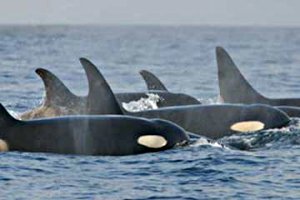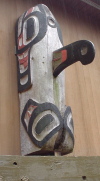
On July 16th, my Mom and I left San Francisco by boat to tour the Southeast coastal islands of Alaska. I have been hearing stories about the untamed Alaska since I was a small child. My mom lived in Kodiak as a girl. Her father and my grandfather had his last tour of Naval duty on Kodiak. His assignment was to survey the numbers of Kodiak bears for the sake of conservation. So I was more than eager to see the wildness and wildlife of Alaska.
While at sea, I've seen common Alaskan wildlife. Humpbacks have spouted and breached, raven and eagles have dived at the water for a dinner of spawning salmon. But I keep looking at the water, hoping to glimpse Orcas. The next opportunity to do so will be tomorrow coming out of the port of Victoria, British Columbia. Orcas, or killer whales as they are commonly known, are not whales at all. They are the largest species of the dolphin family and they are prominent along the Southeast islands of Alaska. They have captured the spirit of natives in these lands. They are alive in their legends and are carved into totem poles that are being preserved in the towns and museums along the coast. Both the native people here and Orcas form matriarchal societies and many native people believe that members of their tribe are reincarnated as killer whales.

Resident Orcas are just one type of Killer Whale. Three groups of Orcas have been found to be genetically separate on the nuclear and mitochondrial DNA level here. Resident Orcas stay close to the shore of the Alaskan islands in herds of up to 200. They have strongly bonded familial ties and are the fisherman of the Orcas, as their diet consists only of fish. Transient Orcas, on the other hand, live also in groups of up to 200 but will split off for the sake of the hunt. They hunt small marine mammals and migrate a great deal more, going where they can find food. While residents have a small and predictable migration route, transients are harder to research because of an unpredictable migration route. Researchers in Alaska have been able to collect more data on resident pods because of their predictability. They identify each individual by their Saddle-patch, or the white markings adjacent to the dorsal fin. It is like a fingerprint, identifying individual Orcas. The third group of Orcas is even more elusive than the transient pods. They are known as the Offshore Orcas. They are known as the rogue of the species and have been very difficult to research because of their unpredictability and often solo migration.
